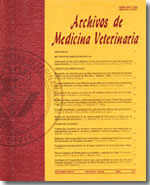Effects of transport time of steers before slaughter on behaviour, weight loss and some carcass characteristics
Main Article Content
Abstract
The effects of 4 road transport times (3, 6, 12 and 24 hr) of steers before slaughter on behaviour patterns, live and carcass weight losses, and some carcass characteristics such as dressing yield, frequency and grade of bruising, pH and muscle colour were evaluated. Two experiments were carried out, one in autumn-winter (OI) and another in spring-summer (PV), with a total of 139 steers of the Friesian breed, all of similar age, live weight and fat cover. Two lorries of similar structure and capacity were used, giving a space allowance of 1m2 for every 500 kg liveweight; according to the weight of the steers this was equivalent to 17 or 18 animals per load, and each load corresponded to one treatment. The steers were weighed on the farm just before loading, at their arrival at the slaughterhouse and prior to slaughter (after 12 +/- 1 hr lairage). The carcasses were weighed immediately after slaughter; pH and colour (Hunterlab) were measured on the Longissimus thoracis muscle, 24 h after slaughter. Descriptive statistics, an analysis of variance and Tukey test were used to determine differences between treatments within each experiment.
Weight losses during transport were 6.5a; 5.0b; 6.0a and 10.5c% in OI; and 4.6a; 7.3b; 8.9c and 11.9d % in PV, for 3, 6, 12 and 24 hours, respectively (P 0.05). No losses in terms of carcass yield were registered due to longer transport times. A higher overall number of bruises was found in the steers transported for 24 hours. Two animals went down in journeys of 12 hours and 7 animals went down in journeys of 24 hours, whilst no steers fell when transported for 3 or 6 hours. The mean pH found in the carcasses of steers transported for 3, 6, 12 and 24 hr respectively was 5.5a, 5.6a, 5.6a and 5.8b in OI; and 5.9a, 5.6b, 5.6b and 5.7b in PV (P 0.05). Mean colour lightness (L) of Longissimus thoracis surface was 28.5a, 27.5ab, 26.2ab and 24.5c in OI and 23.7a, 25.9b, 26.1band 25.8b in PV with 3, 6, 12 and 24 hr transport, respectively (P 0.05). It was concluded that for steers, a transport time of 24 hours by road produces higher live weight losses, more bruises and more animals fall during the journey than shorter transport times therefore, it should be avoided. The results for pH and colour indicate that long journeys as well as short journeys can produce increases in final pH and darker meat, depending on the conditions of each journey.

